Convex Optimization and Its Applications
in Signal Processing
Anthony Man-Cho So
Department of Systems Engineering & Engineering Management
The Chinese University of Hong Kong
Hong Kong
ChinaSIP 2014 Tutorial, July 9, 2014
�
• The main references of this tutorial:
Z.-Q. Luo, W.-K. Ma, A. M.-C. So, Y. Ye, & S. Zhang, “Semidefinite relaxation of
quadratic optimization problems,” IEEE Signal Process. Mag., May 2010.
S. Cui, A. M.-C. So, & R. Zhang, “Unconstrained & constrained optimization problems,”
Chapter 14 of Mathematical Foundations for Signal Processing, Communications, and
Networking, CRC Press, 2012.
[Zhi-Quan Luo, Wing-Kin Ma, Anthony Man-Cho So, Yinyu Ye, and Shuzhong Zhang]
[VOLUME 27 NUMBER 3 MAY 2010]
[From its practical deployments and scope
of applicability to key theoretical results]
In recent years, the semidefinite relaxation (SDR) technique has been at
the center of some of very exciting developments in the area of signal
processing and communications, and it has shown great signifi-
cance and relevance on a variety of applications. Roughly speak-
ing, SDR is a powerful, computationally efficient approximation
technique for a host of very difficult optimization problems. In
particular, it can be applied to many nonconvex quadratically
constrained quadratic programs (QCQPs) in an almost
mechanical fashion, including the following problem:
min
x [ Rn
s.t.
xTCx
xTF
i
x $ gi,
i 5 1, c, p,
xTH
x 5 li,
i
i 5 1, c, q,
(1)
1, c, Fp, H
1, c, Hq are
where the given matrices C, F
assumed to be general real symmetric matrices, possibly
indefinite. The class of nonconvex QCQPs (1) captures
many problems that are of interest to the signal process-
ing and communications community. For instance, con-
sider the Boolean quadratic program (BQP)
min
x [ Rn
s.t.
xT Cx
2 5 1, i 5 1, c, n.
xi
(2)
The BQP is long known to be a computationally difficult prob-
lem. In particular, it belongs to the class of NP-hard problems.
Nevertheless, being able to handle the BQP well has an enormous
impact on multiple-input, multiple-output (MIMO) detection and
multiuser detection. Another important yet NP-hard problem in the
nonconvex QCQP class (1) is
Digital Object Identifier 10.1109/MSP.2010.936019
© BRAND X PICTURES
IEEE SIGNAL PROCESSING MAGAZINE [20] MAY 2010
1053-5888/10/$26.00©2010IEEE
A. M.-C. So, Convex Optimization and Its Applications, ChinaSIP 2014 Tutorial
1
�
• Acknowledgment: Shuguang Cui, Tom Luo, Wing-Kin (Ken) Ma, Yinyu Ye,
Rui Zhang, & Shuzhong Zhang for co-authoring the above articles; Qiang Li,
Jiaxian Pan, Xiaoxiao Wu & Xiao Fu for helping prepare this slides.
• A good part of this tutorial is based the one given in ICASSP 2014 with Ken
Ma.
A. M.-C. So, Convex Optimization and Its Applications, ChinaSIP 2014 Tutorial
2
�
Outline
• Part I: Crash course on convex analysis and convex optimization
• Part II: Quadratically constrained quadratic programs and semidefinite programming
• Part III: Semidefinite relaxation: Theory, and implications in practice
• Part IV: Applications and latest advances
– A. transmit beamforming
– B. advanced topics in transmit beamforming
– C. sensor network localization
• Conclusion
A. M.-C. So, Convex Optimization and Its Applications, ChinaSIP 2014 Tutorial
3
�
Part I: Crash Course on Convex Analysis
and Convex Optimization
A. M.-C. So, Convex Optimization and Its Applications, ChinaSIP 2014 Tutorial
4
�
Convex Functions: Definition and Examples
• Let S ⊂ Rn be given. A function f : S → R ∪ {+∞} is convex on S if for any
x1, x2 ∈ S and α ∈ (0, 1),
f (αx1 + (1 − α)x2) ≤ αf (x1) + (1 − α)f (x2).
(†)
• Geometrically,
{αx1 + (1 − α)x2 : α ∈ [0, 1]}
is the line joining x1 and x2. Hence, the inequality (†) simply says the chord
joining (x1, f (x1)) and (x2, f (x2)) lies above the function.
y
f (x1)
f (x2)
x1
x2
x
A. M.-C. So, Convex Optimization and Its Applications, ChinaSIP 2014 Tutorial
5
�
Convex Functions: Definition and Examples
Some examples of convex functions:
• Any affine function f : Rn → R; i.e., f (x) = aT x + b for some a ∈ Rn and
b ∈ R.
• Any norm k · k on Rn.
– This follows from the triangle inequality.
i=1 αifi(x) for any α1, . . . , αm ≥ 0.
• Any non-negative combination of convex functions f1, . . . , fm : S → R; i.e.,
f (x) =Pm
• Let S ⊂ Rn be a convex set; i.e., for any x1, x2 ∈ S and α ∈ (0, 1), we have
αx1 + (1 − α)x2 ∈ S. Then, the indicator function 1S : Rn → R ∪ {+∞} of S,
which is given by
1S(x) = 0
if x ∈ S,
+∞ otherwise,
is convex on Rn.
A. M.-C. So, Convex Optimization and Its Applications, ChinaSIP 2014 Tutorial
6
�
Convex Functions: Definition and Examples
• Sometimes it is difficult to establish the convexity of a function directly from
matrices, convex on Rn?
the definition.
– Is Rn ∋ x 7→ xT Ax, where A ∈ Sn and Sn is the set of n× n real symmetric
– Is Rm×n ∋ X 7→ σ1(X), where σ1(X) is the largest singular value of the
++ ⊂ Sn is the set of n × n positive
– Is Sn
matrix X, convex on the set of m × n matrices Rm×n?
definite matrices, convex on Sn
++ ∋ X 7→ − log det X, where Sn
++?
• It would be good to have some alternative, hopefully easier, ways to establish
the convexity of a given function.
A. M.-C. So, Convex Optimization and Its Applications, ChinaSIP 2014 Tutorial
7
�

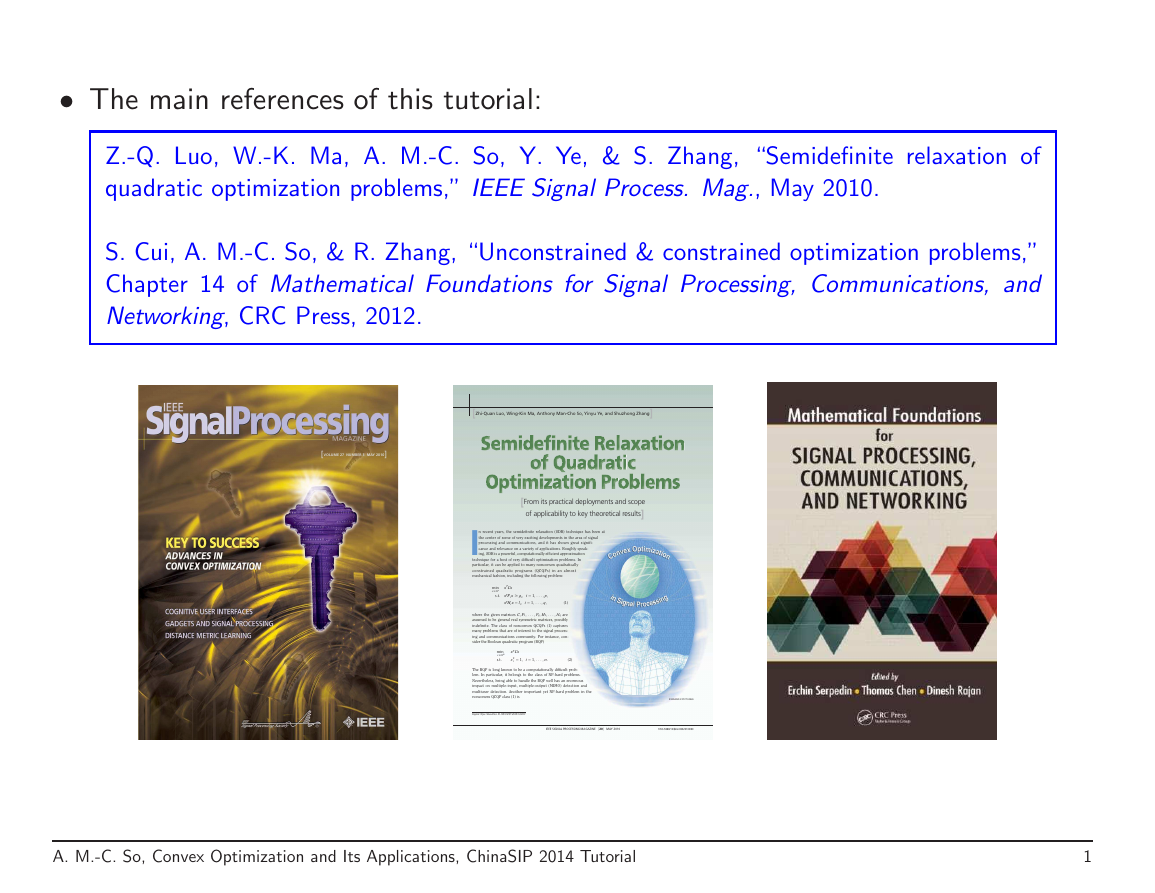
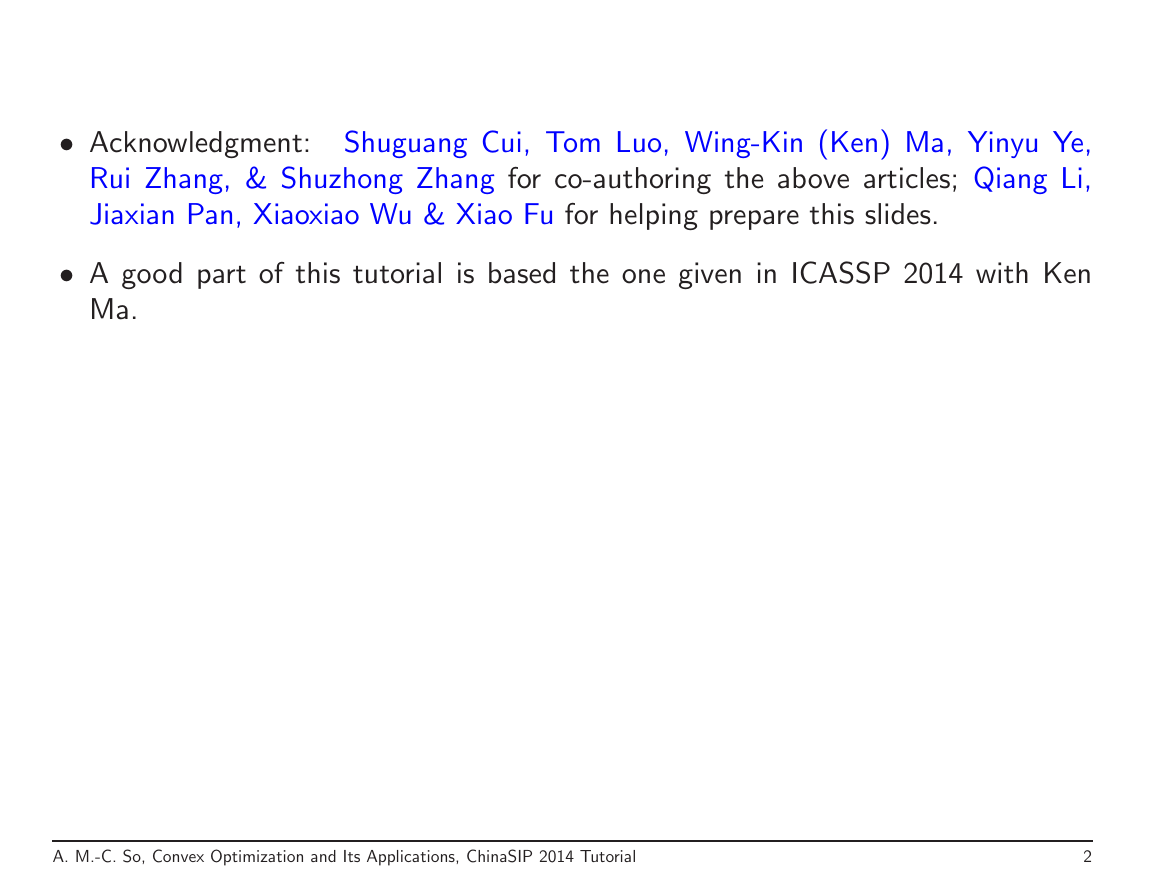
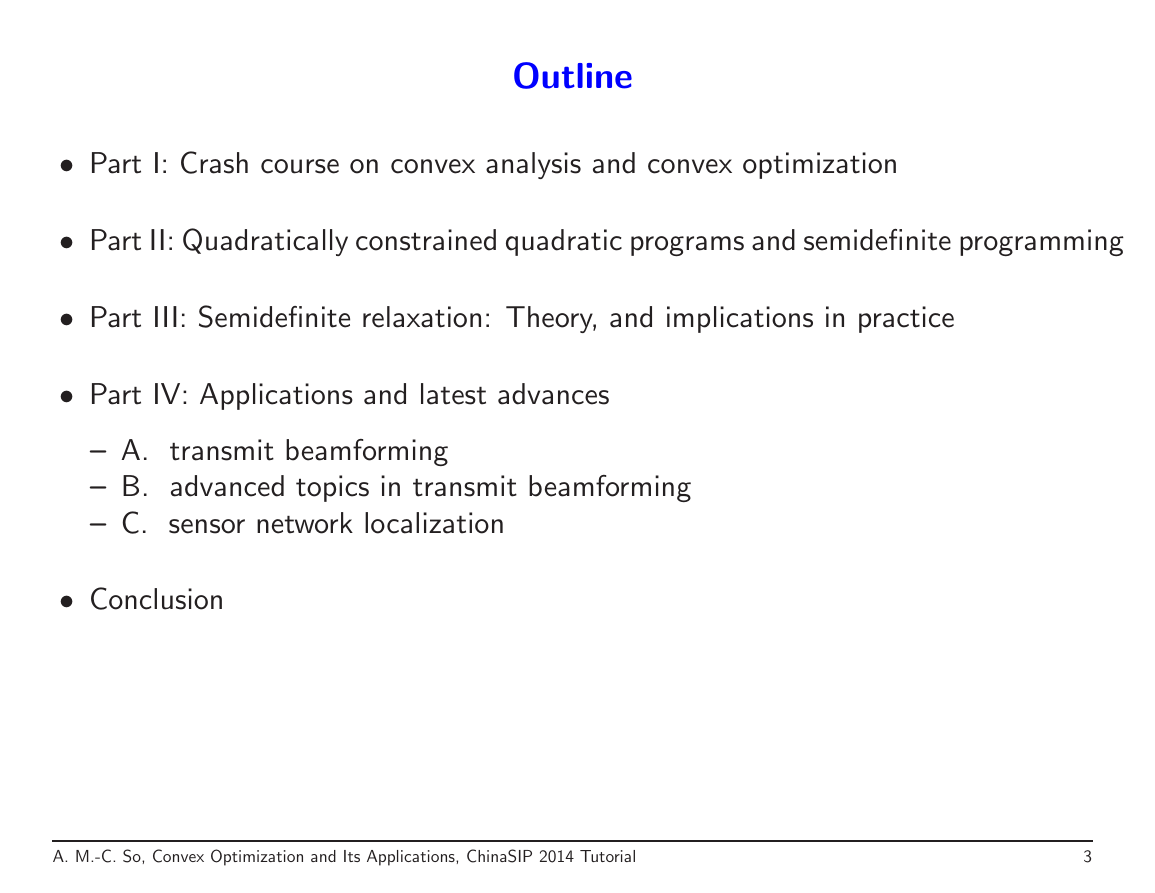
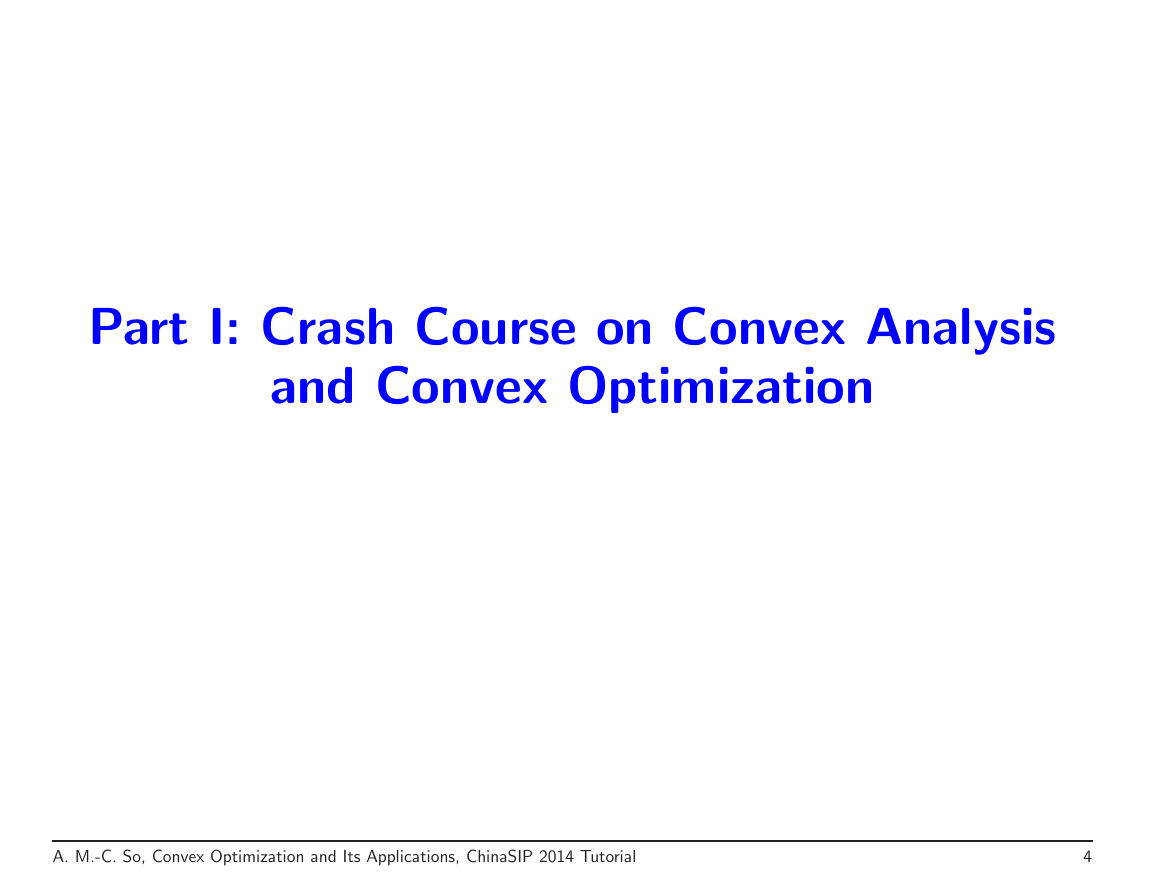
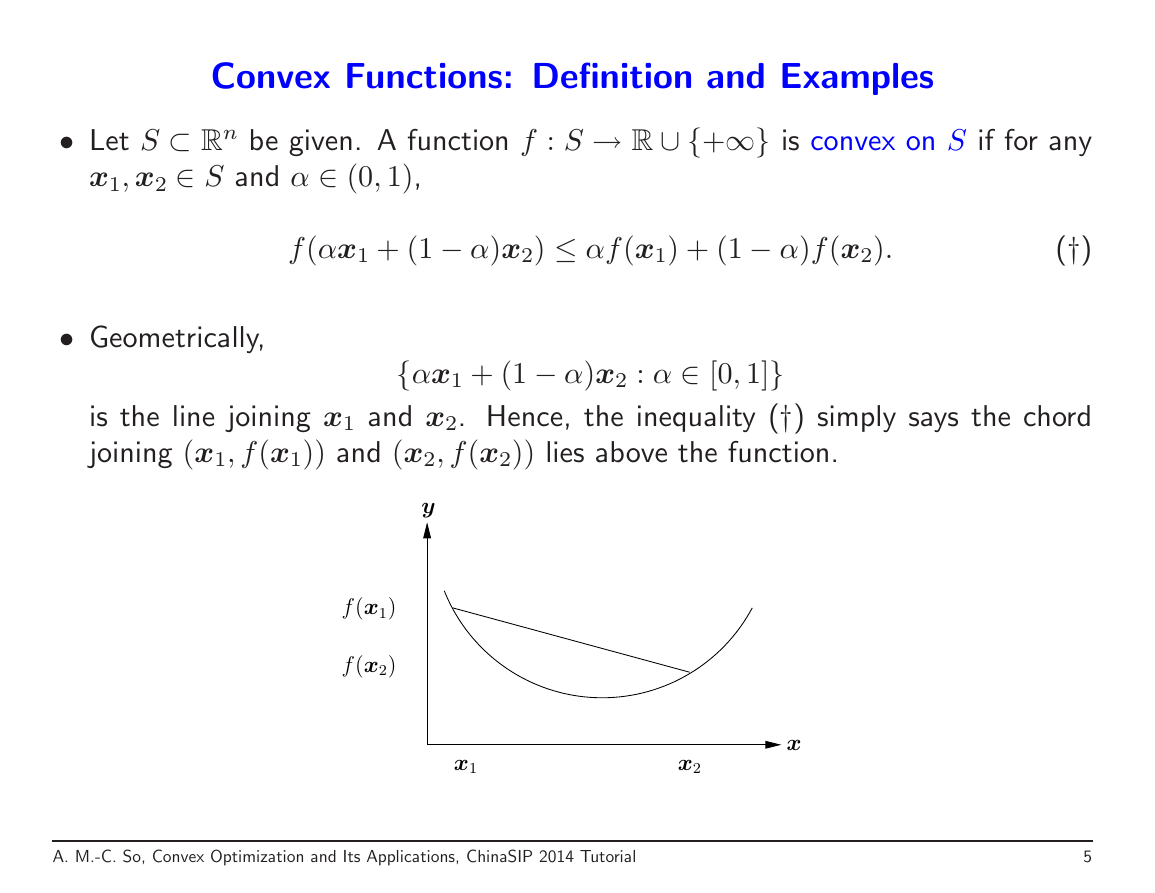
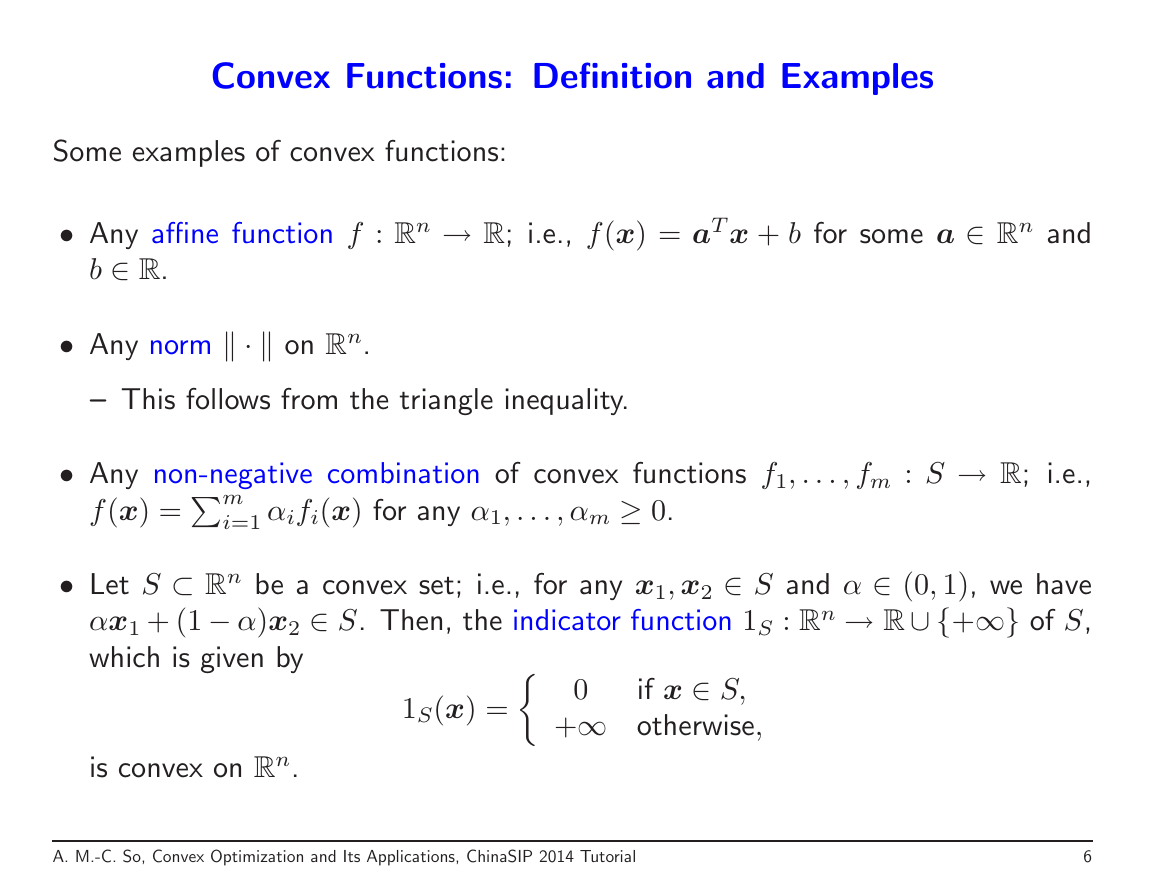
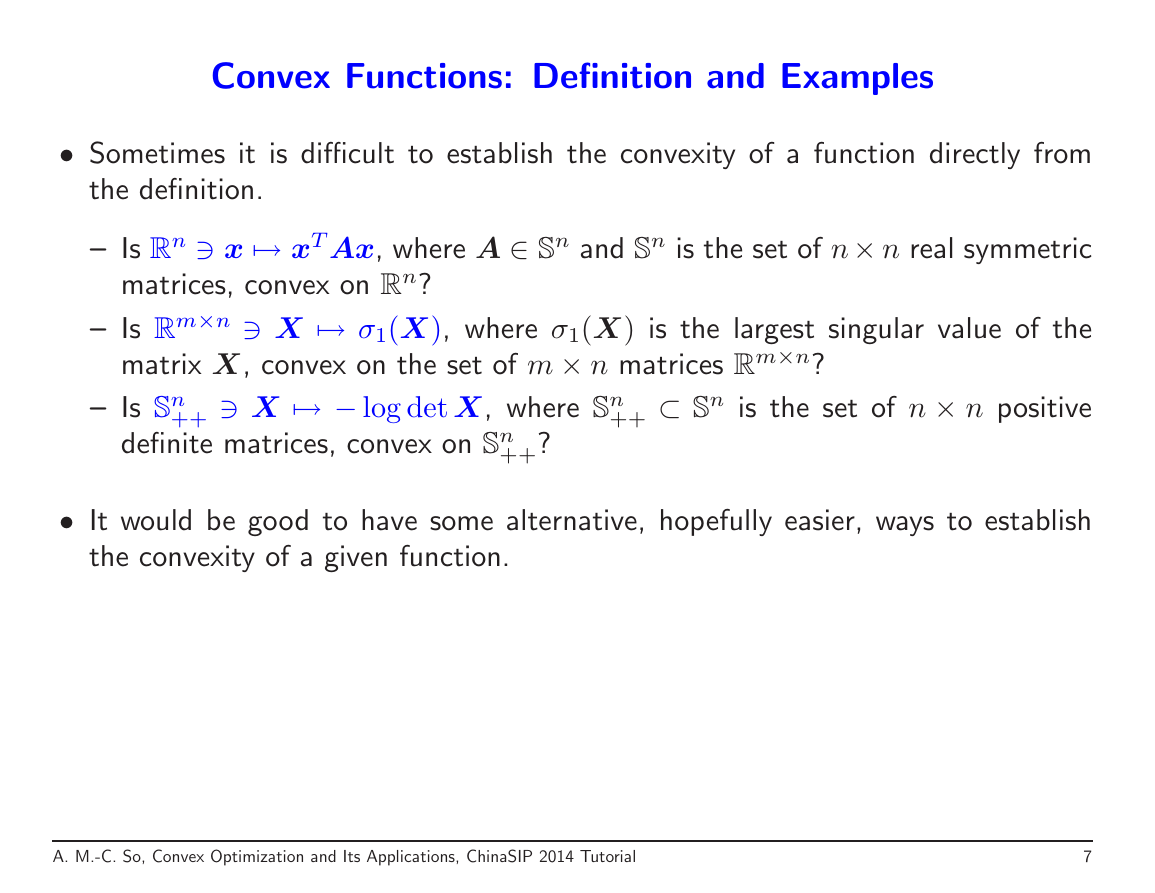








 2023年江西萍乡中考道德与法治真题及答案.doc
2023年江西萍乡中考道德与法治真题及答案.doc 2012年重庆南川中考生物真题及答案.doc
2012年重庆南川中考生物真题及答案.doc 2013年江西师范大学地理学综合及文艺理论基础考研真题.doc
2013年江西师范大学地理学综合及文艺理论基础考研真题.doc 2020年四川甘孜小升初语文真题及答案I卷.doc
2020年四川甘孜小升初语文真题及答案I卷.doc 2020年注册岩土工程师专业基础考试真题及答案.doc
2020年注册岩土工程师专业基础考试真题及答案.doc 2023-2024学年福建省厦门市九年级上学期数学月考试题及答案.doc
2023-2024学年福建省厦门市九年级上学期数学月考试题及答案.doc 2021-2022学年辽宁省沈阳市大东区九年级上学期语文期末试题及答案.doc
2021-2022学年辽宁省沈阳市大东区九年级上学期语文期末试题及答案.doc 2022-2023学年北京东城区初三第一学期物理期末试卷及答案.doc
2022-2023学年北京东城区初三第一学期物理期末试卷及答案.doc 2018上半年江西教师资格初中地理学科知识与教学能力真题及答案.doc
2018上半年江西教师资格初中地理学科知识与教学能力真题及答案.doc 2012年河北国家公务员申论考试真题及答案-省级.doc
2012年河北国家公务员申论考试真题及答案-省级.doc 2020-2021学年江苏省扬州市江都区邵樊片九年级上学期数学第一次质量检测试题及答案.doc
2020-2021学年江苏省扬州市江都区邵樊片九年级上学期数学第一次质量检测试题及答案.doc 2022下半年黑龙江教师资格证中学综合素质真题及答案.doc
2022下半年黑龙江教师资格证中学综合素质真题及答案.doc